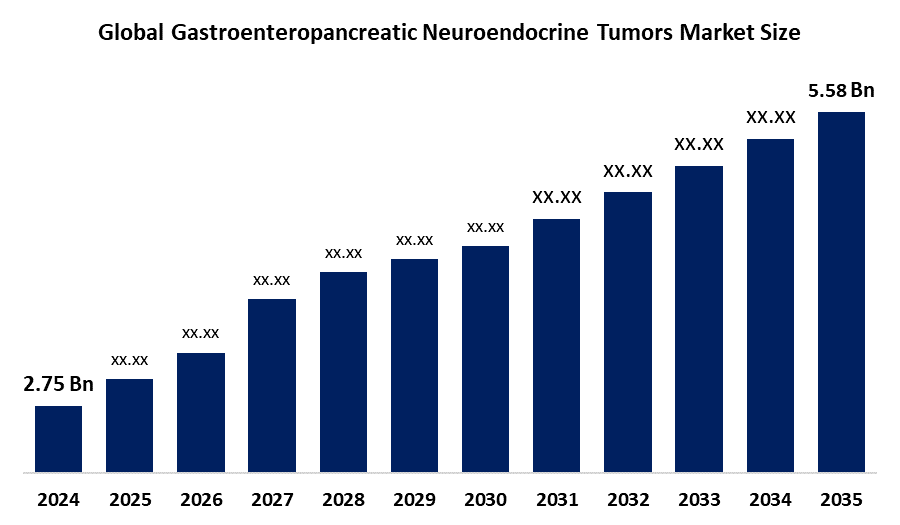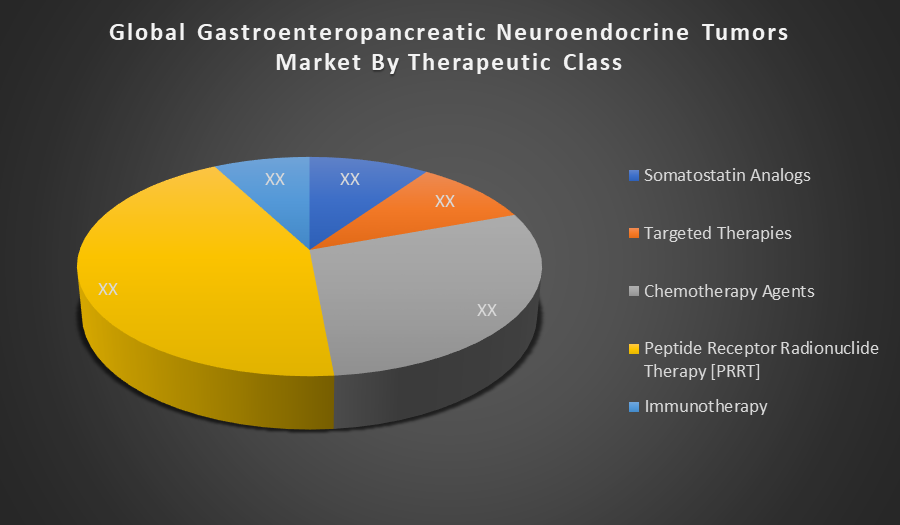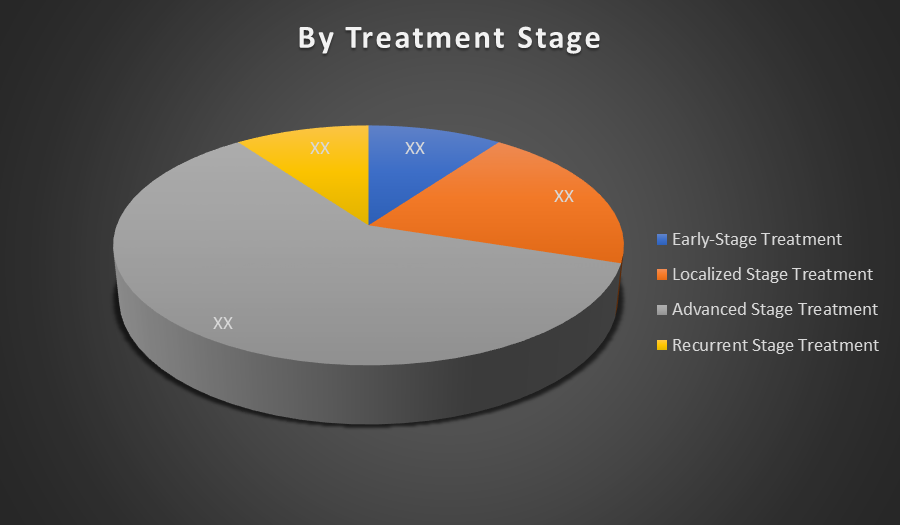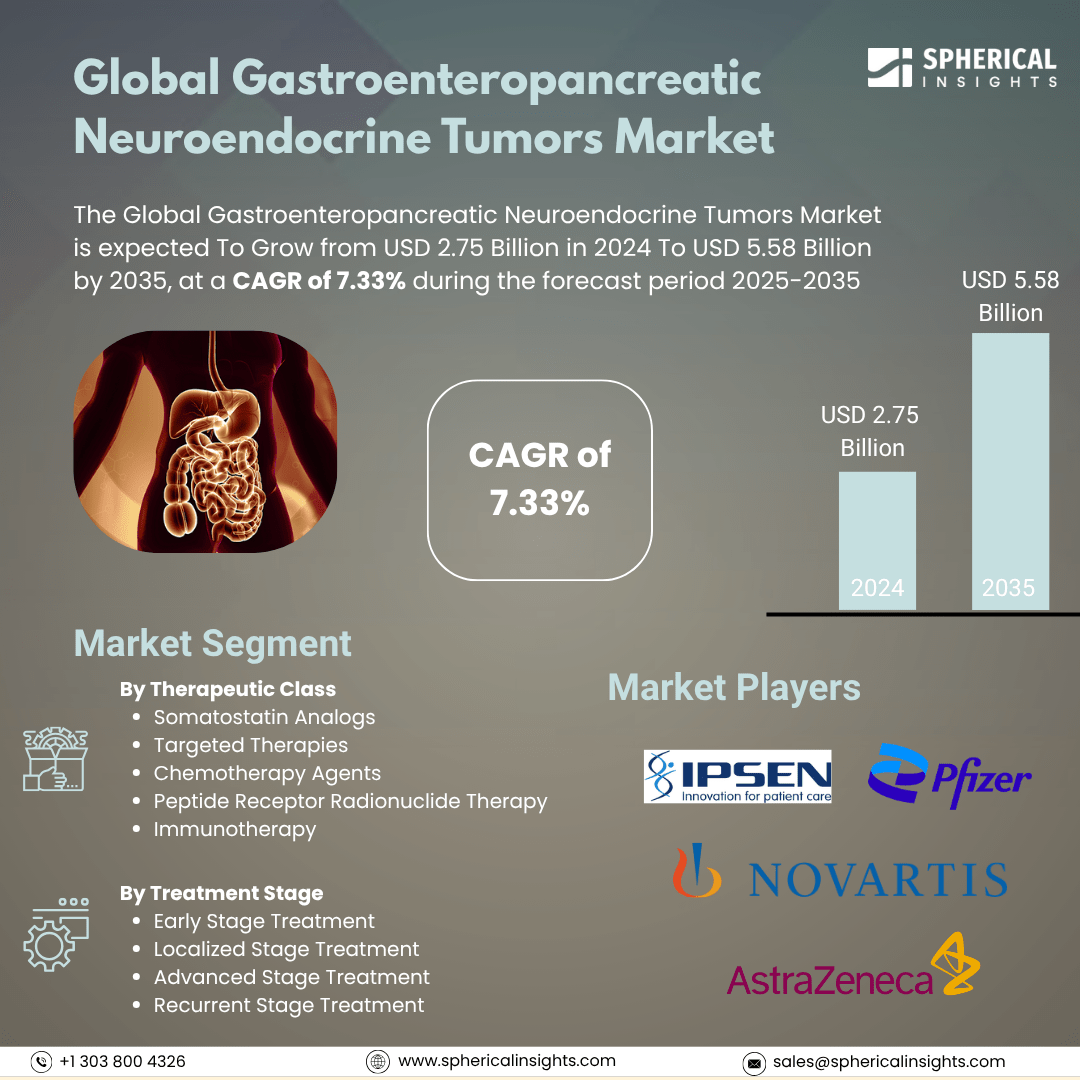- As per Spherical Insights & Consulting, The Global Gastroenteropancreatic Neuroendocrine Tumors Market Size is expected To Grow from USD 2.75 Billion in 2024 to USD 5.58 Billion by 2035, at a CAGR of 7.33% during the forecast period 2025-2035, owing to the launch of new therapies in the market and the rise in the number of cases.
- The leading Gastroenteropancreatic Neuroendocrine Tumors Market Companies such as Ipsen, Novartis, Pfizer, AstraZeneca, Novartis, GlaxoSmithKline, Merck and Co, Ipsen Pharma, Sanofi, Bristol Myers Squibb, Bayer AG, Roche, Eli Lilly, Takeda Pharmaceutical, Celgene, and Others.

Gastroenteropancreatic Neuroendocrine Tumors Treatment Market: Understanding and Treatment Algorithm:
Gastroenteropancreatic Neuroendocrine Tumors are rare tumors originating from neuroendocrine cells in the gastrointestinal tract and pancreas. They can be slow-growing or aggressive, often producing hormones causing various symptoms. Early diagnosis is challenging, and treatment includes surgery, targeted therapies, and hormone regulation to manage tumor growth and improve patient quality of life.
Gastroenteropancreatic Neuroendocrine Tumors Diagnosis:
Gastroenteropancreatic Neuroendocrine Tumors diagnosis involves a combination of imaging techniques like CT, MRI, and PET scans, alongside biochemical tests measuring hormone levels. Endoscopy and biopsy confirm tumor type and grade. Early diagnosis is challenging due to nonspecific symptoms, making advanced imaging and specialized tests essential for accurate detection and treatment planning.
Gastroenteropancreatic Neuroendocrine Tumors Treatment
Gastroenteropancreatic Neuroendocrine Tumors treatment depends on tumor size, location, and stage. Options include surgical removal, targeted therapies like everolimus and sunitinib, hormone therapy to control symptoms, peptide receptor radionuclide therapy (PRRT), chemotherapy for aggressive tumors, and supportive care to improve quality of life.
Gastroenteropancreatic Neuroendocrine Tumors Epidemiology
The disease epidemiology covered in the report provides historical as well as forecasted epidemiology segmented by Total Diagnosed Incident Population of Gastroenteropancreatic Neuroendocrine Tumors, Gender-specific Diagnosed Incidence of Gastroenteropancreatic Neuroendocrine Tumors, Type-specific Diagnosed Incidence of Gastroenteropancreatic Neuroendocrine Tumors, Age-specific Diagnosed Incidence of Gastroenteropancreatic Neuroendocrine Tumors, Diagnosed Incident Population based on Primary Site of Gastroenteropancreatic Neuroendocrine Tumors, and Diagnosed Incident Population based on Histologic Classification of Gastroenteropancreatic Neuroendocrine Tumors Tumour in the global market covering North America, Europe, Asia-Pacific, Latin America, the Middle East, and Africa from 2024 to 2035.
Principal Insights
This section offers a global overview of gastroenteropancreatic neuroendocrine tumors epidemiology in major markets worldwide.
Country Wise- Gastroenteropancreatic Neuroendocrine Tumors Multiforme Epidemiology
- The epidemiology segment provides Gastroenteropancreatic Neuroendocrine Tumors prevalence data and findings across key regions worldwide, including North America, Europe (Germany, France, Italy, Spain, and the United Kingdom), Asia-Pacific (including Japan), Latin America, the Middle East, and Africa.
Gastroenteropancreatic Neuroendocrine Tumors: Recent Developments:
- In April 2023, Novartis received FDA approval for Lutathera (lutetium Lu 177 dotatate) as the first treatment specifically for pediatric patients aged 12 and older with somatostatin receptor positive gastroenteropancreatic neuroendocrine tumors. This approval marked a significant milestone, expanding treatment options for younger patients and reinforcing Lutathera’s role in targeted radioligand therapy for GEP NETs.
Gastroenteropancreatic Neuroendocrine Tumors Marketed Drugs:
- Lutathera (lutetium Lu 177 dotatate): Novartis
Lutathera is a targeted radioligand therapy for somatostatin receptor-positive GEP NETs. It delivers radiation directly to tumor cells, improving progression free survival, especially in inoperable or metastatic cases. It’s FDA approved for both adults and pediatric patients.
- Cabometyx (cabozantinib): Exelixis
Cabometyx is an oral kinase inhibitor targeting pathways involved in tumor growth and angiogenesis. It is used for advanced pancreatic and extra pancreatic GEP NETs, particularly after prior therapy failure, helping to slow disease progression.
- Sandostatin (octreotide): Novartis
Sandostatin is a somatostatin analog that controls hormone-related symptoms in functioning GEP NETs and helps stabilize tumor growth. Available in short and long acting forms, it is widely used for symptom management.
Gastroenteropancreatic Neuroendocrine Tumors: Emerging Therapies
- TAS 102 (trifluridine or tipiracil): TAS 102 is an oral chemotherapy drug being investigated for advanced GEP-NETs. It works by interfering with DNA synthesis in cancer cells, aiming to slow tumor growth in patients who have exhausted other treatment options.
- Surufatinib: Surufatinib is a small-molecule tyrosine kinase inhibitor targeting VEGFR, FGFR, and CSF 1R pathways. It is in late-stage trials for GEP NETs, designed to inhibit tumor angiogenesis and modulate the tumor microenvironment to improve patient response.
- Bavencio (avelumab): Bavencio is a PD L1 immune checkpoint inhibitor being tested for GEP-NETs. It helps reactivate the immune system to recognize and kill tumor cells, particularly in patients who do not respond well to current immunotherapies.
- BNT327: BNT327 is a bispecific antibody in late stage clinical trials for GEP NETs. It simultaneously targets two immune checkpoints, enhancing T cell activation and boosting the immune system’s ability to attack tumors. It aims to improve treatment outcomes, especially in patients who are resistant to conventional PD 1 or PD L1 immunotherapies.
Gastroenteropancreatic Neuroendocrine Tumors Market Outlook
- The Gastroenteropancreatic Neuroendocrine Tumors (GEP NETs) market encompasses the development, manufacturing, and sale of diagnostics, treatments, and therapies for neuroendocrine tumors in the gastrointestinal tract and pancreas. It includes drugs, surgical procedures, and emerging therapies aimed at improving patient outcomes and quality of life.
- The GEP NETs market is driven by rising incidence and diagnosis rates, advancements in targeted therapies and diagnostic technologies, growing awareness among healthcare professionals, increasing demand for personalized treatments, and supportive government initiatives promoting research and drug development to improve patient survival and quality of life.
- Opportunities in the GEP NETs market include the development of novel targeted therapies and immunotherapies, expansion of early diagnostic tools, increasing patient awareness, growing healthcare infrastructure in emerging markets, and collaborations between pharmaceutical companies and research institutions to address unmet medical needs and improve treatment outcomes.
- Governments worldwide are funding research programs and awareness campaigns to improve early detection and treatment of GEP NETs. Regulatory support and expedited approvals are also helping accelerate the availability of innovative therapies for patients.
- Challenges in the GEP NETs market include late diagnosis due to nonspecific symptoms, limited treatment options for advanced stages, and high costs associated with novel therapies, hindering widespread accessibility.
- The market is projected to grow significantly due to rising incidence, advanced diagnostics, and new targeted therapies, with increasing demand across global regions.
Gastroenteropancreatic Neuroendocrine Tumors Market Segmentation
By Therapeutic Class:
- Somatostatin Analogs
- Targeted Therapies
- Chemotherapy Agents
- Peptide Receptor Radionuclide Therapy [PRRT]
- Immunotherapy

Peptide Receptor Radionuclide Therapy (PRRT) holds the largest market share among therapeutic classes for GEP NETs due to its targeted action, high efficacy in advanced cases, and premium pricing. Though used in fewer patients than somatostatin analogs, its role in treating complex, progressive tumors makes it a major revenue contributor globally.
By Treatment Stage:
- Early Stage Treatment
- Localized Stage Treatment
- Advanced Stage Treatment
- Recurrent Stage Treatment

The Advanced Stage Treatment segment dominates the GEP NETs market due to the high number of cases diagnosed at later stages, when tumors have already spread or become inoperable. These cases require long term, systemic therapies like targeted drugs, PRRT, and immunotherapy, driving greater demand in this treatment stage.
Regional Segment Analysis of the Gastroenteropancreatic Neuroendocrine Tumors Market
North America holds the largest share in the Gastroenteropancreatic Neuroendocrine Tumors market due to its highly developed healthcare infrastructure and substantial healthcare expenditure. The region benefits from a strong presence of leading pharmaceutical companies, advanced diagnostic technologies, and well-established clinical trial networks. Additionally, supportive government policies and faster regulatory approvals help accelerate the introduction of innovative therapies, further driving market expansion.
The Asia Pacific region is the fastest growing market for GEP NETs, driven by rapidly improving healthcare infrastructure and increasing awareness about neuroendocrine tumors among both patients and healthcare providers. Growing investments in healthcare, rising disposable incomes, and expanding insurance coverage enable greater access to advanced treatments. Furthermore, increasing incidence rates of GEP NETs and expanding urban populations are contributing to heightened demand, making the region a key focus for market players aiming for long-term growth.
Gastroenteropancreatic Neuroendocrine Tumors Market Key Companies
- Ipsen
- Novartis
- Pfizer
- AstraZeneca
- Novartis
- GlaxoSmithKline
- Merck and Co.
- Ipsen Pharma
- Sanofi
- Bristol Myers Squibb
- Bayer AG
- Roche
- Eli Lilly
- Takeda Pharmaceutical
- Celgene
- Others
Gastroenteropancreatic Neuroendocrine Tumors Therapeutics Market Report Scope
- The Gastroenteropancreatic Neuroendocrine Tumors therapeutics market report provides a detailed overview, covering its causes, symptoms, disease progression, and existing treatment options.
- Detailed insights into Gastroenteropancreatic Neuroendocrine Tumors’s epidemiology and therapeutic approaches are included.
- Additionally, a comprehensive review of existing and emerging Gastroenteropancreatic Neuroendocrine Tumors therapies is provided, including an evaluation of new treatments expected to influence the current Gastroenteropancreatic Neuroendocrine Tumors treatment market landscape.
- The report includes a detailed review of the Gastroenteropancreatic Neuroendocrine Tumors therapeutics market, both historical and forecasted, highlighting the global drug reach.
- The Patient Based Gastroenteropancreatic Neuroendocrine Tumors Market Forecasting report offers valuable insights into trends shaping the global Gastroenteropancreatic Neuroendocrine Tumors market, helping to develop effective business strategies.
Gastroenteropancreatic Neuroendocrine Tumors Treatment Market Report Insights
- Forecasting Market Trends Based on Patient Data and Disease Rates
- Gastroenteropancreatic Neuroendocrine Tumors Therapeutic Approaches in Gastroenteropancreatic Neuroendocrine Tumors
- Review Of Drugs in Development for Gastroenteropancreatic Neuroendocrine Tumors
- Market, Growth, and Trends in Gastroenteropancreatic Neuroendocrine Tumors
- Market Opportunities in Gastroenteropancreatic Neuroendocrine Tumors Treatment
- Effects Of Future Therapies on Gastroenteropancreatic Neuroendocrine Tumors Treatment.
Gastroenteropancreatic Neuroendocrine Tumors Treatment Market Report Key Strengths
- 15 Years Gastroenteropancreatic Neuroendocrine Tumors Market Forecast
- Global Coverage
- Gastroenteropancreatic Neuroendocrine Tumors Epidemiology Segmentation
- Key Cross Competition
Gastroenteropancreatic Neuroendocrine Tumors Treatment Market Report Assessment
- Present Practices in the Gastroenteropancreatic Neuroendocrine Tumors Treatment Market
- Review of Investigational Gastroenteropancreatic Neuroendocrine Tumors Drugs
- Attractiveness of the Gastroenteropancreatic Neuroendocrine Tumors Drug Market
- Gastroenteropancreatic Neuroendocrine Tumors Market Drivers
- Gastroenteropancreatic Neuroendocrine Tumors Market Barriers
- SWOT
- Attribute Analysis
Market Segment
This study forecasts revenue at the global, regional, and country levels from 2020 to 2035. Spherical Insights has segmented the gastroenteropancreatic neuroendocrine tumors market based on the below-mentioned segments:
Global Gastroenteropancreatic Neuroendocrine Tumors Market, By Therapeutic Class
- Somatostatin Analogs
- Targeted Therapies
- Chemotherapy Agents
- Peptide Receptor Radionuclide Therapy [PRRT]
- Immunotherapy
Global Gastroenteropancreatic Neuroendocrine Tumors Market, By Treatment Stage
- Early Stage Treatment
- Localized Stage Treatment
- Advanced Stage Treatment
- Recurrent Stage Treatment
Global Gastroenteropancreatic Neuroendocrine Tumors Market, By Regional Analysis
- North America
- Europe
- Germany
- UK
- France
- Italy
- Spain
- Russia
- Rest of Europe
- Asia Pacific
- China
- Japan
- India
- South Korea
- Australia
- Rest of Asia Pacific
- South America
- Brazil
- Argentina
- Rest of South America
- Middle East & Africa
- UAE
- Saudi Arabia
- Qatar
- South Africa
- Rest of the Middle East & Africa






